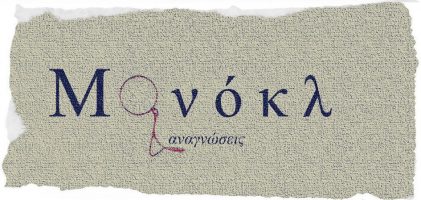
το όν ορίζει
μορφές πέτρινης ύλης
ένα, σε πέντε
Το gorinto (παγόδα πέντε στοιχείων) είναι ένα μνημείο μεγάλης ομορφιάς και παρουσίας, μοναδικό για την Ιαπωνία. Λατρεύω την απλή, αλλά βαθιά δομή του με πέντε γεωμετρικά σχήματα, τοποθετημένα το ένα επάνω από το άλλο. Αντιπροσωπεύουν τα «godai», τα «πέντε μεγάλα» στοιχεία που απαρτίζουν το Σύμπαν και εμάς : Γη, Νερό, Φωτιά, Αέρας / Άνεμος και Διάστημα / Αιθέρας.

αιώνια γη
της Άνοιξης Δή-μητρα
ιερό χώμα

της Γοργούς δάκρυ
Ωκεανούς αλλάζει
αλμυρή ζωή
Τα Gorinto γεννήθηκαν από τις διδασκαλίες του βουδισμού Shingon Vajrayana πριν από 800 χρόνια και βρίσκονται τώρα σε όλη την Ιαπωνία. Χρησιμοποιούνται κυρίως ως ταφόπλακα, μνημείο και λειψανοθήκη.Έχω επισκεφτεί πολλές τοποθεσίες σε όλη τη χώρα, για να απολαύσω από κοντά, την ποικιλομορφία και την ιερότητα της ύπαρξης τους.

πύρινη γλώσσα
του Προμηθέα δώρο
αλχημείας νους
Το αγαπημένο μου μέρος είναι το Koyasan, το συγκρότημα ορεινών ναών Shingon κοντά στο Κιότο, όπου δεκάδες χιλιάδες gorinto βρίσκονται ανάμεσα σε ένα πανύψηλο παλιό δάσος. Είναι ένα μέρος που αγγίζει την ψυχή και την καρδιά με την ομορφιά, την πνευματικότητα και το σεβασμό για το πέρασμα μας μέσα από τη ζωή και στον επόμενο κόσμο.

κίνηση πνοής
αόρατα εισχωρεί
άνεμος θα’ ναι
Υπάρχει κάτι εξαιρετικά χαλαρωτικό στην ιερή γεωμετρία των gorinto, την αισθάνεσαι «σωστή». Η βάση της δομής τους έχει σχήμα κύβου, που αντιπροσωπεύει τη Γη. Ακολουθεί το νερό, σε σχήμα σφαίρας και μετά η φωτιά, με τριγωνικές πλευρές. Το μικρότερο ημισφαιρικό σχήμα αέρα / ανέμου έρχεται στη συνέχεια και τελευταίο με τη στεφάνη της δόξας, ένα κόσμημα ή σχήμα άνθος λωτού. Η συνείδηση, το έκτο στοιχείο του βουδισμού Shingon, εγχύεται σε ολόκληρη τη μορφή.

ψηλά, στο κενό
το τέλος φωτίζοντας
θεϊκή καρδιά
Η ομοιότητα αυτών των γεωμετρικών σχημάτων με τα Πλατωνικά Στερεά, όπως έμεινε στην Ιστορία από τον Πλάτωνα στον διάλογο του Τιμαίου γύρω στο 360 π.Χ., είναι εντυπωσιακή. Αποδίδει ένα στοιχείο σε καθένα από τα πέντε βασικά σχήματα του Σύμπαντος – τον κύβο που αντιπροσωπεύει τη Γη,το εικοσάεδρο (σφαίρα) που αντιπροσωπεύει το νερό • το τετράεδρο που αντιπροσωπεύει τη φωτιά, το οκτάεδρο που αντιπροσωπεύει τον αέρα • και ο Ουρανος που εκπροσωπείται από το δωδεκάεδρο. Μέσα στο χώρο και στον χρόνο, αυτές οι ιερές μορφές του Πλάτωνα και του Shingon – και τα στοιχεία που αντιπροσωπεύουν – μας συνδέουν όλους.

στο χώμα πάνω
η μνήμη ακίνητη
ρέει, σαν πέτρα
Η ενέργεια που ενσωματώνεται στο gorinto είναι πάρα πολύ ισχυρή. Η ιερή γεωμετρία της έχει βαθύ συμβολισμό και αποτελεί επί μακρόν το επίκεντρο του διαλογισμού, μια πρακτική με την οποία μπορούμε όλοι να ασχοληθούμε.Κάθε στοιχειώδες σχήμα έχει πολλές σχέσεις – με διαφορετικά μέρη του σώματος, διαφορετικά χρώματα, τσάκρας και άλλα. Η καθαρή μορφή του gorinto έχει αναδημιουργηθεί από καλλιτέχνες, όπως ο Kawaii Kanjiro (σε πηλό με καμίνους) και ο Hiroshi Sugimoto (σε γυαλί οπτικής ποιότητας). Ως σύμβολο της απόλυτης ενότητας όλης της ύπαρξης, το gorinto έχει μεγάλη αισθητική γοητεία και μπορεί να μας βοηθήσει να αξιοποιήσουμε τις εσωτερικές μας δυνατότητες για ευημερία.

The gorinto: Japanese sacred geometry in Platonic form
the being defines
forms of stone material
one, in five
The gorinto (five-elements pagoda) is a monument of great beauty and presence, unique to Japan. I love its simple yet profound structure of five geometric-shapes, stacked one above the other. They represent ‘godai’, the ‘five great’ elements that make up the Universe and ourselves – Earth, Water, Fire, Air/Wind and Space/Ether.
eternal Earth
Spring of Demetra’s womb
our sacred land
Medusa’s tears
changing the Oceans
a salty life
The gorinto was born out of the teachings of Shingon Vajrayana Buddhism over 800 years ago and is now found all over Japan. Used mainly as a grave-marker, memorial and reliquary, I have visited sites across the country to delight in the diversity and sacredness of their ‘being’. My favourite place is Koyasan, the Shingon mountain Temple complex near Kyoto, where tens of thousands of gorinto nestle among towering old growth forest. It is a place that touches your soul and heart with its beauty, spirituality and reverence for our passage through life and into the next world.
flaming tongue
present of Prometheus
alchemy mind
movable breath
invisibly penetrates
must be the wind
There is something remarkably calming about the sacred geometry of the gorinto. It feels ‘right’. The base of the structure is a cube shape, representing Earth; Water, in the shape of a sphere comes next; this is followed by Fire, with triangular sides; the smaller Air/Wind hemispherical shape comes next; with the crowning glory a jewel or lotus bud shape. Consciousness, the sixth element of Shingon Buddhism, is infused throughout the entire form.
high up in the void
illuminating the end
a divine heart
The similarity of these geometric shapes to the Platonic Solids, immortalised by Plato in the Timaeus dialogue around 360 BC, is striking. He ascribed an element to each of the five fundamental shapes of the Universe – the cube representing Earth; the icosahedron (sphere) representing Water; the tetrahedron representing Fire, the octahedron representing Air; and the Heavens represented by the dodecahedron. Across space and time these sacred forms of Plato and Shingon – and the elements they represent – connect us all.
above the ground
memory is still
like a floating stone
The energy embodied in the gorinto is immensely powerful. Its sacred geometry has deep symbolism and has long been a focus for meditation, a practice we can all engage in. Each elemental shape has many associations – with different parts of the body, different colours, chakras and more. The pure form of the gorinto has been recreated by artists such as Kawaii Kanjiro (in kiln-fired clay) and Hiroshi Sugimoto (in optical quality glass). As a symbol of the ultimate oneness of all existence, the gorinto has great aesthetic appeal and can help us tap our inner potential for well-being.
Professor Jann Williams
Tasmania, Australia
March 14, 2021
Biographical notes of Jann Williams:
JANN WILLIAMS is an award-winning ecologist, writer and photographer who lives in Tasmania and is a frequent visitor to Japan. She is an Adjunct Professor at the University of Western Australia and recipient of the prestigious 2019 Gold Medal Award presented by the Ecological Society of Australia. Jann is a member of Writers in Kyoto (WiK) and was chief editor and designer of Encounters with Kyoto, the 2019 WiK Anthology. Her blog www.elementaljapan.com shares her unique experiences exploring the elements in Japan.
Η καθηγήτρια κ. Jann Williams είναι βραβευμένη οικολόγος, συγγραφέας και φωτογράφος που ζει στην Τασμανία και επισκέπτεται την Ιαπωνία συχνά. Είναι επίκουρη καθηγήτρια στο Πανεπιστήμιο της Δυτικής Αυστραλίας και της απονεμήθηκε το διάσημο βραβείο, Χρυσό μετάλλιο από την Οικολογική Εταιρεία της Αυστραλίας, το 2019. Η Jann είναι μέλος των Συγγραφέων στο Κιότο (WiK) και ήταν επικεφαλής συντάκτης και σχεδιαστής του Encounters with Kyoto, του 2019 WiK Anthology. Στο ιστολόγιό της www.elementaljapan.com μοιράζεται τις μοναδικές εμπειρίες της, εξερευνώντας τα στοιχεία στην Ιαπωνία.
 Maria Papatzelou
Maria Papatzelou
Graduate of the School of Fine Arts of Thessaloniki, a visual artist, scenographer, co-curator of international art projects, radio producer of @ Art in the City, www.entropiaradio.gr and art teacher in Secondary Education. She lives and works in Thessaloniki. She has participated in many group exhibitions, in Greece and abroad (India, London, Kobe , Excellent Prize in International Art Exchange Exhibition Kobe 2017, 2018, 2019 and Kyoto, Japan) and has presented 6 solo exhibitions. She writes Haiku poetry and her first book “Inner Connections of the Liquid Sky” was published in Japan, with translation and comments by Professor Mr. Masashi Nakamura.
She is a member of Theater Maiotron since 1994.
